A BRIGHT FUTURE
As Good As It Gets
You might think that writing about good weather would tempt the fates. I’ll thumb my nose at the fates and go ahead and write that this spring is the best spring, gardenwise, ever in all the decades since I’ve been gardening. The flowers have been more vibrant with color and, it seems, also in greater profusion. The air has been particularly fragrant, especially now with the intoxicating aroma of black locust blooms following closely on the heels of autumn olive’s sweet scent.
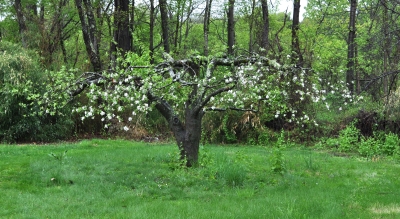
My fruit trees are most thankful for this spring’s beneficence. In all the years of growing fruit here on the farmden, never has the landscape been so brightened by snowballs of white blooms of plum and pear trees, pinkish blossoms of apples, and peaches’ pure pink blossoms.
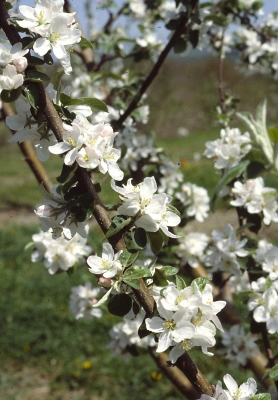
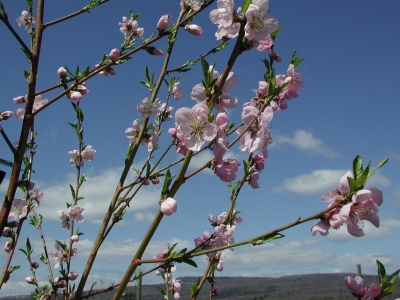
The now-fallen petals are no cause for wistfulness, because those clusters of flowers have now morphed into clusters of fruits
Why this Year?
What makes for such a glorious spring? The weather, of course, both this spring’s in addition to last winter’s and even last spring’s. Let’s first go back to last spring’s weather effects.
During spring 2020 the weather warmed going into April, coaxing flower buds on fruit trees to swell. Then, towards the end of that month and into May, a number of nights saw temperatures that nipped life from many flowers, then open, especially the 22° temperature on April 23rd and then subfreezing temperatures on May 9th, 13th, and 14th. (All this information handily recorded and passed onto my computer via Sensorpush sensors I have at two locations outdoors and one location in the greenhouse.)

Prelude to the present season began with a relatively mild winter, for which peach flower buds, which suffer damage at around minus 15°, were especially appreciative. And this spring has seen more or less gradually warming temperatures with — and this is most important — no late, damaging frosts. Buds for a current spring’s blossoms develop the summer of the previous year. Seeds in developing fruits produce a hormone that suppresses flower bud formation, so a heavy crop one year means a lighter crop the following year, and vice versa, all other things being equal. Last year’s late frosts knocked out much of the potential fruit crop so this year the trees did what they do, compensating for last year’s loss with more blooms.
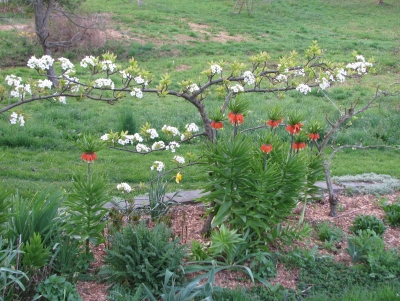
Fruit trees can afford to lose a certain number of flowers to cold each year. For instance, each flower bud of an apple tree unfolds to five flowers, and only 5 percent of those flowers need to set fruit for a full crop of apples. Furthermore, a temperature below 32° doesn’t always cause damage; just how much damage ensues depends on the the growth stage of flower buds and how cold it gets. Using apples, again, as an example, when their buds have expanded just enough to hint at the five flowers within (the “tight cluster” stage), 27° will kill 10 percent of them, 21° will kill 90 percent of them. More details for apples and other fruits can be found here.
Another variable is that temperatures can vary a little at various points within a tree, which can be important at these critical temperatures.
Not Yet Home Free
This auspicious spring is not a call for me to just sit back and wait for the delicious bounty to hang on the branches awaiting my picking. My work is cut out for me.
One job, to begin soon, will be thinning the fruit, that is, removing lots of them. In addition to upping the chances for a good return bloom and harvest next year (remember the seeds and the hormones), fruit thinning lets the trees channel more of their energy resources into fewer fruits. The result: Fruits that remain are larger and more flavorful. Fruit thinning also lessens the chance of limbs breaking under the the load of too many fruits, and lessens pest problems. Two apples touching each other provide good cover for the larvae of codling moths to burrow into the fruits to become the classic “worm in the apple.”
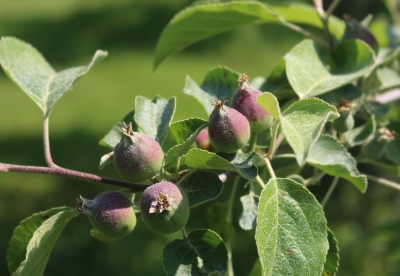 Commercially, tree fruits are thinned with chemical sprays but I’ll be thinning by hand. The plan is to reduce the number of fruits to one per bud, leaving the largest and most pest-free, and allowing remaining fruits to sit no closer than about a half a foot apart along branches. Larger kinds of fruits are the ones that need thinning, which is nice because it would be very tedious to thin small fruits, such as cherries. Winter pruning removes some branches with fruit buds, so also contributes to reducing the load, as does trees’ natural shedding of some excess fruits.
Commercially, tree fruits are thinned with chemical sprays but I’ll be thinning by hand. The plan is to reduce the number of fruits to one per bud, leaving the largest and most pest-free, and allowing remaining fruits to sit no closer than about a half a foot apart along branches. Larger kinds of fruits are the ones that need thinning, which is nice because it would be very tedious to thin small fruits, such as cherries. Winter pruning removes some branches with fruit buds, so also contributes to reducing the load, as does trees’ natural shedding of some excess fruits.
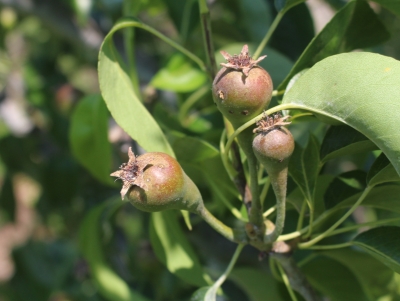
Another job, which began a few weeks ago, is keeping an eye out for and protecting fruits from insects and diseases — particularly problematic on a less than perfect site such as here on the farmden. All of the common tree fruits, except for pear, are very prone to these problems throughout much of eastern North America.
On a backyard scale, the problems are few but serious, in some cases serious enough to eliminate almost the whole crop or render it inedible. The major culprits are plum curculio, codling moth, apple maggot, oriental fruit moth, brown rot, apple scab, fire blight, and cedar apple rust. Not to mention deer and squirrels.
My tack is to take a multi-pronged approach, with some spraying (mostly organic), nurturing the soil (lots of mulch and compost) and the plants (pruning and fruit thinning), fostering beneficial insects with plantings that encourage their presence and with careful choice and limited amount of sprays, trapping pests (hanging fake apples, Red Delicious, with sticky Tanglefoot in trees), and possibly bagging individual fruits. See Grow Fruit Naturally for more about these approaches.
Even if there is “many a slip ‘twixt the cup and the lip,” every fruit grower has to be an optimist.
Plant Sale Reminder
This is the last week of my annual plant sale. For more information, go to https://leereich.com/2021/05/last-week-of-2021-plant-sale.html
And, A Free Webinar, “Weedless Gardening”
For more information, go to www.leereich.com/workshops.

